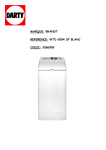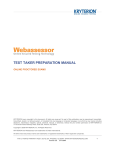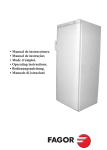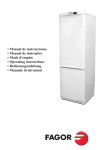Download Fagor LFI-040IT dishwasher
Transcript
e n g l i s h Instruction Manual This appliance, which is intended exclusively for domestic use, has been designed for washing dishes. Very important: Read all of this manual before installing and using the dishwasher. You will find the documentation and accessories inside. This manual is designed so that the text matches the corresponding drawing. 0 If the appliance is to form part of a row of kitchen fittings, fit the kitchen skirting and if opening the door interferes with it, trim the end until the door can open properly. Identification If you need to fit a piece of wood to the front, follow the instructions that come with the appliance documentation. Identify your dishwasher model (“a”, “b”, “c”, “d” or “e”) by comparing the control panel with the illustrations. 1 Installation 1.1 Connection to the water supply (1.1.1) The hose should run between the wall and the bottom of the dishwasher (1.1.2), making sure that the pipes are not twisted or pulled too tight (1.1.3). The water supply pressure should be between 0.05 and 1 Mpa (0.5 to 10 kg/cm2) If your dishwasher has a hot water intake, you can connect the pipe to the hot water tap. In this case, the maximum temperature should not exceed 60ºC. For column mounting, take the height of the drain into account (1.2.2) 2 2.1 Open the door and switch on the dishwasher by pressing the button (2.1). 2.2 Hard water. Water contains lime and its hardness increases in direct proportion to the quantity found. Before using the dishwasher, you should find out the hardness level of the water by consulting the water company, consulting the Technical Support Service or using the Aquadur strip included in the accessories bag. 1.2 Drain. Fit the elbow supplied and observe the levels in the drawing (1.2.1). Dip the stick in a glass of water for one second. Shake it and wait for one minute. The strip will tell you the water hardness level according to the following table: 1.3 Connection to the mains electricity supply. Take the information on the nameplate (1.3) into account and never attempt to remove it. As this is a built-in appliance, the electrical plug must be accessible after installation. 1.4 For fitting the dishwasher under a worktop, first take into account the dimensions shown in the diagram (1.4.1). loosen and remove the leg supports (1.4.2). Then place the dishwasher in front of the worktop and use a screwdriver to raise the rear leg from the front (1.4.3), leaving a space of approx. 3 mm from the worktop. Insert the dishwasher and ensure that the pipes and cable do not get trapped behind the skirting. Adjust it to the worktop by turning the front legs (1.4.4) and rear leg (1.4.3) until the top of the appliance is just touching the worktop. Initial settings Hardness Dial position Test result Scale Scale level (DH) level (HF) Man Elec No salt needed L0 Standard Pos. 1 L1 1 red strip 8-21 DH 14-38 HF Medium Pos. 2 L2 2 red strips 22-28 DH 39-50 HF Hard Pos. 3 L3 3 red strips 29-35 DH 51-63 HF Very hard Pos. 4 L4 4 red strips Soft Green 0-13 DH 0-13 HF >35 DH >63 HF HF: Water hardness (French system) DH: Water hardness (German system) This simple adjustment of the dishwasher is vital for correct operation. Please ensure that you do it. Otherwise your appliance could be seriously affected. 19 e n g l i s h If the level is 0, DO NOT use salt. If you have any questions, consult the technical support service. Electronic setting. If your model is type A, hold down the Opc button (2.2.1) for more than 3 seconds. The current value will appear on the display when you release it L2 (2.2.2) Press the same key several times until you reach the required value. Validate by pressing button (2.2.3). If your model has a Time Delay (2.2.4) or Duo Zone (2.2.5) or 1/2 Load (2.2.6) button, hold this button down for at least 3 seconds. When you release it, the current L2 value will appear on the display (2.2.2), or pilot lights will flash (2.2.7). Press the same key several times until you reach the required value. Validate by pressing PROG button (2.2.8). For all other models (models “e” without Option buttons), hold down the PROG button for at least 5 seconds. On releasing the button the current value will be shown by flashing pilot lights (2.2.7). If the model has less than 5 programmes, level 0 will be shown by the pilot lights switching off (except for the steady END/STOP light) (2.2.9). Press the PROG button repeatedly until the desired value is reached. Validate by releasing the PROG button and not pressing it again for at least 10 seconds. After this time, it will automatically store the value and exit to the main menu. 2.3 Preliminary cleaning. You should run a preliminary wash (without detergent, dishes or rinse aid). First of all, if you need to, load the dishwasher with salt (2.3.1) without completely filling the compartment. Fill it up with water (2.3.2) and stir with a spoon. Close the lid and start the programme. 3 Use 3.1 Regulating the top basket. Types of regulation (3.1.1) 20 SUPER EASY: hold the basket by the side handles and pull upwards with both hands at the same time (both to raise and lower it)(3.1.2). Ensure that it is level. NORMAL: with the basket empty, remove the stops (3.1.3); take the basket out (3.1.4); insert it at the required height and fit the stop back into place. 3.2 Putting the dishes into the machine. Ensure that the dishes are dishwasher-safe. It is not advisable to put items made of wood, silver, aluminium, decorated porcelain or non heat-resistant plastic into the dishwasher. For correct washing, it is essential that the dishes are positioned suitably in the baskets without touching each other. The lower basket is for the dirtiest items: casserole dishes, bowls and plates. Start to fill the basket from the outside (3.2.1). Put the casserole dishes in facing down, the soup dishes on the left and the plates on the right. If you have dropdown supports, you can use them in their horizontal position for large items such as casserole dishes (3.2.2 - 3.2.3). Put the cutlery in with the handle facing downwards (3.2.4) Knives and other sharp utensils should be placed in the basket with their points downwards or horizontally. The top basket is for delicate items: cups, glasses, porcelain, crystal and standard size plates (3.2.5). There is an area for long utensils and dropdown supports that can be used for wine glasses when put into vertical position (3.2.6). For the Express programme or the Top Load function , all of the dishes should be placed in the Top Basket (3.2.7). And for the Bottom Load function, the dishes will be placed only in the Bottom Basket (3.2.3). Ensure that there is no obstacle preventing the sprinklers from turning around (3.2.8) or the detergent compartment from opening. e n g l i s h Top/bottom load (duo-zone) 3.3 Detergent. You can use tablets, powder or liquid. The amount to be used is detailed in the progammes table. Pour the required dose into the compartment located inside the door (3.3.1) and close the lid. In programmes that require an additional dose, place it on top of the lid (3.3.2). 3.4 Switching on (with the door open) . Uses half of the dishwasher capacity. Top basket , Bottom basket , or both. Half Load (1/2) This is the same as Top Load (only the top basket is used) . 3.5. Checking salt and rinse aid levels. Salt. If the pilot light is lit up, you have to fill the compartment. You should not use salt if you do not need it (note in section 2.2). If you do need it, follow the steps explained in section 2.3, but fill the compartment completely with salt. If your appliance does not have a warning light, you should fill the salt compartment up after every 20 washes for medium-hard water. Any change of programme will deactivate options that are not compatible. 3.8 Delay Timer Allows you to delay the Dishwashing start time. Press the key several times until you see the delay required on the screen (3.8.1) or pilot (3.8.2). If you want to cancel the delay, press . 3.9 Start-up Rinse aid. If the pilot is lit or the indicator light (3.5.1) inside the door is a light colour, always refill until the compartment is completely full (3.5.2). For A type models, press the button (2.2.6) and close the door. For other models, simply close the door. On display models (type B), the selected programme will appear (P1, P2, etc.) After the programme has started, if you wish to change the programme or option, open the door carefully (there is a risk of splashes) and restart the dishwasher . 3.6 Programme Selection. Programme selection using the PROG button (2.2.10) 3.7 Selecting options. All in 1 detergent only) (A type models Hold down the and OPC buttons simultaneously for more than 3 seconds (3.7.1). If you use ALL-IN-ONE detergents, the washing or drying results (and the times) may be negatively affected, mainly in the case of short and/or low temperature programmes. It is important to read the instructions on the packet (3.3.3). If in doubt, consult the detergent manufacturer. Time reduction Shortens washing and drying times. This can be used for the Intensive, Normal or Automatic, Hygienizer and Economy Programmes For all models, when you close the door a programme start beeper will sound. 3.10 Dishwashing process. If there is a power cut during the programme, once the power has been restored, the dishwasher will continue to operate normally from the same point at which it stopped. It is not advisable to open the dishwasher door while it is in the process of washing. Results could be affected. If you do, watch out for hot water splashing out. 3.11 End of programme. When the programme ends, the appliance will emit a beep and the END (STOP) pilot light will come on, if your model has one.. Switch off the machine to energy saving. . It will contribute 3.12 Warnings about use. Avoid having the door open to avoid accidents (3.12.1). 21 4 e n g l i s h Maintenance Leave the dishwasher slightly open if you are going to be away for some time so that the air can circulate inside it. It is advisable to carry out the following maintenance every month: 4.1 Cleaning the washing filter. It is under the lower basket of the dishwasher. Remove the basket and extract the filter by turning it counter clockwise(4.1.1). Take it out and wash it under tap (4.1.2). Fit it again by turning it clockwise(4.1.3). Ensure it is fitted correctly by pulling it upwards. 4.2 Cleaning the sprinklers. Remove the top sprinkler (if it has one) by pressing it upwards and unscrewing it (4.2.1). Unscrew the middle sprinkler (4.2.2). Remove the lower one by turning the lever counter clockwise and lifting it upwards (4.2.3). Wash them under the tap with a soft sponge that does not leave scratches. Make sure that none of the holes are blocked. 4.3 Cleaning the inside. Clean the inside of your dishwasher using a dishwasher cleaner or specific cleaning product following the instructions. 4.4 Cleaning the outside. We recommend using a damp cloth with soapy water. Do not use abrasive products or those that leave scratches. 5 Safety • Do not use extension leads or adapters to connect the dishwasher. • The electricity supply should be at the maximum power indicated on the nameplate and the plug should have the regulatory earth connection. • If the power cable is damaged, it must be replaced by the after-sales service or by qualified personnel in order to avoid any danger. • Do not attempt to touch the inside of it. In the event of any problem that you cannot solve, contact the technical support service. 22 • Any people (including children) whose physical, sensorial or mental limitations or lack of experience and knowledge prevents them from using the appliance safely, must NOT use this appliance without the supervision or instructions of a responsible adult. Children should be supervised to ensure that they do not play with the appliance. 6 Environment 7 Diagnoses This dishwasher has been designed with environmental conservation in mind. Please respect the environment. Load the dishwasher to the maximum recommended capacity for each programme, positioning the dishes correctly, and choose the appropriate programme and options; this will save you water and energy. Whenever you can, avoid using the pre-wash programme. Do not use too much detergent. Management of old electrical and electronic appliances. Do not discard appliances by mixing them with general household waste. Hand over your old dishwasher to a special collection centre. Recycling household appliances avoids negative consequences for health and the environment and leads to the saving of the energy and resources. For more information, contact your local authority or the store where you purchased your dishwasher. 7.1 Technical problems or malfunctions. When the dishwasher detects a malfunction, it will advise you with alarm and visual signals, depending on the model: Models with screen. The letter "F" is displayed, followed by a number as well as beeps (7.1.1) Models without screen. It emits continuous series of beeps from 1 to 10. Example: 4 beeps - pause - 4 beeps - ... is the same as F4.es lo mismo que F4. e n g l i s h The operation of the dishwasher could be occasionally affected by the spillage of dirt. Therefore, to avoid problems, check the following aspects depending on the fault detected. As a first option, switch the machine off and on again (Reset) MODELS WITH SCREEN MODELS WITHOUT SCREEN No. OF BEEPS FAULT TYPE: Door F1 1 F2 2 Water inlet F3 3 Drain F4 4 Overflow F5 5 Temperatura F6 6 Temperature F7 7 F8 8 Operating Pressure F9 9 Water Distribution F0 10 Communication Comments Aspects to be reviewed: User Is the dishwasher door shut? Is there water in the system?, Is the water supply on?, Is the filter of the input electrovalve clean?, Is the water inlet hose lying straight and not twisted between the wall and the dishwasher?, Is the drain at a higher level than the dishwasher compartment? Is the drain hose free from blockages?, Is the hose straight?, Are filters clean?, Has the selected programme really ended? Are the filters clean and free from dirt, puree, mash, etc.? Run a programme with dishwasher cleaner… It may be due to the accumulation of dirt and lime scale deposits in the heating system. Run a programme with dishwasher cleaner… It may be due to the accumulation of dirt and lime scale deposits in the heating system. Temperature Detection Switch off the machine and start a new programme Switch off the machine and start a new programme Run a programme with dishwasher cleaner. It may be due to deposits that have formed If the fault persists, contact your technical support service. If the fault persists, contact your technical support service. Before calling, check the fault code. Remember that if you switch the machine off cancel the malfunction signals. you will When you open the door, the beeper is deactivated. If you want to hear the beeps again, press the button (on A type models) or the PROG button (on other models) Solving inefficiency problems: Machine does not wash. Wrong programme? Consult the programmes table; Has the machine been loaded correctly? See section 3.2; Are the sprinklers turning freely and/or are the holes blocked? See sections 3.2 - 4.2; Is the filter fitted correctly? See section 4.1; Are you using the right detergent? Make sure that it is appropriate for use in the dishwasher and it has not been damaged by keeping it stored for a long time. Machine does not dry. Wrong programme? In short programmes, drying efficiency is reduced; is the correct amount of rinse aid being used? See section 3.5; If I use an All-in-1 tablet, can I do without rinse aid? The use of rinse aid considerably improves drying efficiency; are the dishes loaded correctly? See section 3.2; Are the items to be dried appropriate? For example, Tupperware (plastic) items are not suitable for drying; when do you remove the items from the dishwasher? It is advisable to wait 15 or 20 minutes after the programme ends. The dishwasher does not switch on. Check the electricity supply, the power connection, whether fuse has blown or whether you have pressed the on switch correctly . The programme does not start. Check whether the door is open or whether you have pressed the start button correctly (A type models only). 23 e n g l i s h Programmes table PROGRAMME TEMPERATURE (°C) SYMBOLS TYPE OF DISHES QUANTITY OF DETERGENT (gr) *** Pre-wash Cold For dishes that are not going to be washed right away Hygienizer 75ºC For bacteria removal 25+5 Intensive 70ºC For very dirty dishes and casseroles 25+15 Normal 65ºC For dirty dishes 25+15 25+5 or Auto Without detergent 55ºC - 65ºC Economic* 50ºC For not very dirty dishes Quick 55ºC For dishes that are hardly dirty 25 OptiA 60ºC For not very dirty dishes. 60min 25 Express ** 40ºC For dishes that are hardly dirty only placed in the top basket 20 50ºC For dirty dishes that are delicate 25+5 45ºC Special crystal programme 25 15 min. Mixed Delicates** 25 gr. of non-concentrated powdered detergent is equivalent to one and half level spoonfuls or one detergent tablet. For tablet and liquid detergents follow the recommendations of the detergent manufacturer. * The economic programme, standardised according to EN-50242, lasts longer than the other programmes; however, it uses less energy and is better for the environment. ** The Express programme and Delicates programme should use powdered or liquid detergent which dissolve best. *** If using combined washing products (All-in-1 tablets) be aware that they can modify the consumption parameters and duration of the programmes. Keep the additional information on programme duration and consumption. CONSERVE IT. The programme information is laboratory-obtained data in accordance with the EN 50242 Standard. It is random data and may therefore vary on day-to-day use. 24 I II 0 1 1.1.1 1.1 1.1.2 1.1. 2 1.1.3 1.1. 3 Model min. 25cm max. 100 cm a min. 2 cm 25 1.2.1 1.2 1. 2 Serial Number 1.2 2.2 1.2.2 1.3 b 57 ES MANUAL DE INSTRUCCIONES FR MANUEL D’UTILISATION PT MANUAL DE INSTRUÇÕES GB INSTRUCTION MANUAL DE BEDIENUNGSANLEITUNG NL INSTRUCTIEHANDLEIDING CZ NÁVOD K OBSLUZE A INSTALACI PRAâKY HU HASZNÁLATI ÚTMUTATÓ SK NÁVOD NA IN·TALÁCIU A OBSLUHU PRÁâKY IT MANUALE DI ISTRUZIONI GA MANUAL DE INSTRUCIÓNS CA MANUAL D’INSTRUCCIONS EU ERABILERA-ESKULIBURUA Mix 70º 65º 50º 55º 70º 65º 50º 55º PROG PR OG 820 mm 600 m mm m 0m STOP ST OP 50º 1.4.1 1. 4.1 1.4 1. 4 1.4.2 1. 4.2 1.4.3 1. 4.3 1.4.4 1.4. 4 c Mix PROG PR OG STOP ST OP 50º d 2 2.1 2.2 2.2.1 2. 2.1 2.2.2 2.2.2 Mix 70º Mix 70º 0 04/11 03/10 4/1 43 3/1 /110 05/11 DW3M00141 D DW3 DW3M00050 M00141 M00050 0 DW3M00180 65º 50º 55º PROG PR OG 65º 6 50º 55º 50º L0 L1 L2 L3 L4 STOP ST OP 50º e 2.2.3 2. 23 2. 2.2.4 2.2.4 2.2.5 2.2. 5 2.2. 2.2.6 6 2.2. 2.2.7 7 III PROG Mix PROG 65º 50º fin 7 55º STOP L0 L1 L2 L3 L4 50º 2.2.8 2.2.9 2.3 2.3.1 2.3.2 3.5 3.5.1 3.5.2 3.5.1 3.7.1 3.7 3 3.1.1 3.1 3.1.2 3.1.3 3.8 3.8.2 3.8.1 3.12.1 3.12 4 3.1.4 3.2.4 3.2.1 3.2 3.2.5 3.2.2 3.2.6 3.2.3 3.2.7 3.2.8 4.1 4.2 6 3.3 3.3.1 3.3.2 V IV 3.3.3 4.2.1 4.1.1 4.1.2 4.2.2 4.1.3 4.2.3 7.1.1 7.1 Español 1 0DJ\DU Français 7 6ORYHQVN\ Português 13 Italiano 55 English 19 Galego 61 Deutsch 25 Català 67 Nederlands 31 (XVNDUD āHVN\ IV

















